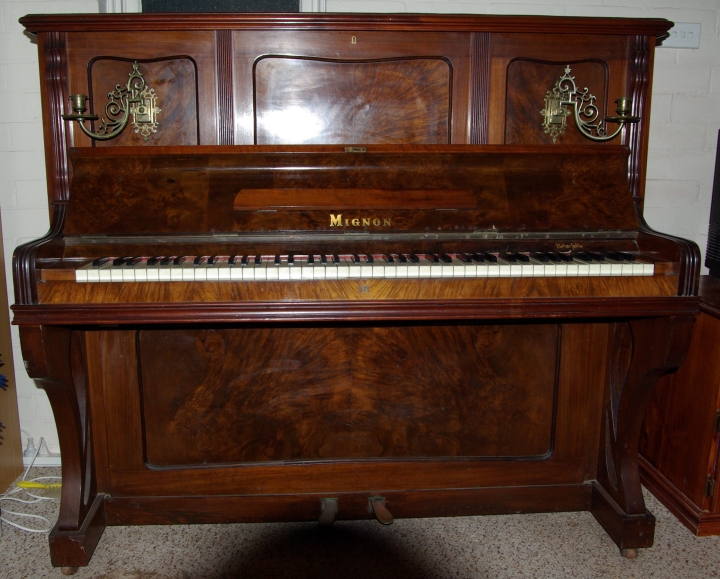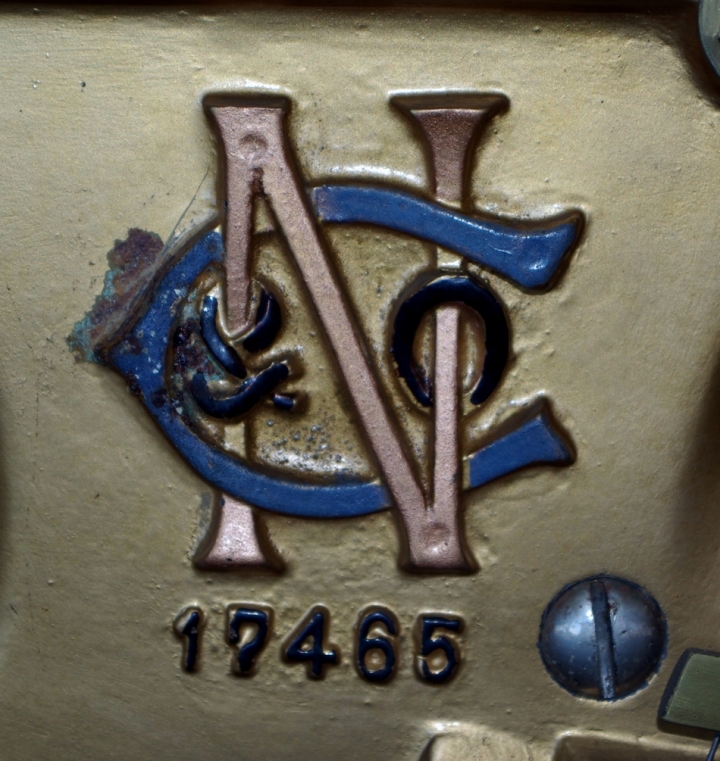How can objects bring back memories and engender a sense of place? Because they carry the history of families. This is my second post on the importance of keeping objects and documenting provenance and significance. The subject of this post is a Mignon upright piano handed down to me by my mother. My first post was about a scrapbook and photographs passed down to me from my great-aunt. The objects are unique links from one generation to another and represent a bond with people who are important to me, to family members and friends.

Upright Piano, ‘Mignon’, timber / metal, made for B. Bebarfald and Company Limited, [Australia], 1890-1920. Photograph Carol Roberts.
The photograph shows the Mignon upright piano with full iron frame, timber case with matched, sliced burred walnut veneer. The piano has a full seven octave keyboard from A to A and has underdamper action. The top door of the piano has three separately framed inset panels, each with a moulded undulating border. There are two decorative brass candleholders attached to the side panels of the top door. The serial number 17465 has been cast in the iron frame, underneath the logo of Nicholson and Company. As well as the word Bebarfalds, the words Made in Germany also appear on the nameboard rail. The piano has two expression pedals and is on castors. There is some warping and lifting of the veneer on the nameboard rail and on the edge of the top. Otherwise, the piano is in very good condition and has been tuned every year since c1974.
The significance of the piano is that it was a gift from my father to my mother, an accomplished pianist, and this piano represents many hours of enjoyable entertainment for family and friends. It has been said that museum historians can never have too much information. Regarding the Mignon, my daughter and I are now the ‘custodians of primary information’ as we lived in the house with the piano. Through the generations, my brother and I and our children and our friends, were brought up listening to the Mignon being played and most of us also played it. We are now the only source of information about the music that ensued from its keys, from early twentieth century song and dance music, through war-time songs, classical music and popular songs, to sing-songs around the piano. Thus it is extremely important to record and document the history and significance of objects such as older musical instruments, to preserve and pass on to future generations an insight as to how previous generations entertained each other and themselves. This piano could be used as a focus for different stories, such as a history of the kinds of music played in the home or a history of furniture stores in Sydney early in the twentieth century, such as Bebarfalds, as the name Bebarfalds is clearly printed in gold lettering on the nameboard rail which indicates that the Mignon piano used in this case study was most likely purchased from the Bebarfalds Store in Sydney.
In our family, music and playing the piano were of paramount importance. Before the Mignon it was a Collard & Collard and before that it was a big, black Blankenstein that had been brought out from Germany. The Collard & Collard was bought by me in the late 1960s as it had a better touch than the old Blankenstein, although the Collard & Collard had a half-timber/half-iron frame which was disappointing from the sound point of view. It was one of the first things I bought with savings earned in my first full-time job. But the old Blankenstein had its own history: great for dance music but somewhat lacking for the dexterity needed for Bach and Mozart. Bought by my great-uncle Robert Hilton Clarke for his sister Charlotte (my grandmother) in about 1917, the piano stayed in our family until it stood in floodwaters for a week in the 1961 flood because it was too heavy to lift. The Blankenstein came to a sorry end in the garage when the piano-tuner said it was going to cost too much to restore. Such a beautiful iron frame gone forever! We still have the candle-holders though: my mother kept them as a memento and had them attached to the Mignon piano c1987! There is evidence on the side panels of the Mignon that there had originally been candelabra on the piano, as the screw-holes have been filled in and varnished.
It was common practice in the late nineteenth and early twentieth centuries for Australian companies to import pianos from Germany and apply a trade name, such as Mignon, before piano factories in Australia became more widespread. The words Made in Germany are printed on the nameboard rail on the Mignon. This is a significant and important historical fact to document because B. Bebarfald & Co. Ltd. has not existed in the Sydney area since 1973 and the store itself is now a part of history. The focus for an interesting story could be a history of German-made pianos commissioned and imported into Australia.

Barnet Bebarfald (c1831-1894) began business in 1857 in Melbourne and in Dunedin as an ‘importer’, before moving to Sydney in the early 1870s. At that time, Bebarfald was listed in the 1873 Sands Directory as running a furniture warehouse at 256 Pitt Street. B. Bebarfald and Company Limited began operating in George Street, opposite the Sydney Town Hall, from about 1894 and an advertisement for a piano department was included in a Bebarfalds furniture catalogue from that period. From about 1920, Bebarfalds began making their own furniture and established a factory at Redfern and at some stage, the Bebarfalds Piano Factory was established at Chippendale and was still operating in 1959
The Mignon Bebarfalds piano has a logo cast in the iron frame clearly showing the letters ‘N & Co’ which represents Nicholson and Company. Nicholson and Company operated a Pianoforte Gallery and Music Warehouse at 325 George Street, Sydney, from the 1880s until well into the mid-twentieth century and were a very respected importer of musical instruments. The Mignon piano is typical of the domestic instruments imported into Australia from Germany during the late nineteenth and early twentieth centuries and represents an era in Australian retailing of importing goods from Europe when Bebarfalds was in the early stages of developing business. The Beale Piano Manufacturing Company, established in 1893, had a piano factory at 41-47 Trafalgar Street, Annandale, New South Wales and they also imported German-made pianos in the late nineteenth and early twentieth centuries. In relation to the Mignon piano, the Pierce Piano Atlas states that Mignon was one of the brands made by the Beale Piano Manufacturing Company. W.H. Paling and Company also distributed Mignon pianos and the connection could be that Nicholson and Company joined with W.H. Paling and Company and became Nicholson Palings.

Nicholson and Company logo cast in the iron frame of ‘Mignon’ piano, clearly showing identification number 17465. Photograph Carol Roberts.

The issue of conservation practices for pianos is quite involved. Older pianos, such as the Mignon, are made of ‘a solid wood core covered on both sides with veneer’ and this assists both with stability and tone. However, it is important that any piano not be placed in a draught, not be positioned against an outside wall and not be exposed to hot, humid summers and dry, cold winters because extremes of temperature can cause the soundboard to crack. Very damp conditions can also cause the strings and tuning pins to rust. Humidity stabilising systems can be installed in pianos and in fact I have such a system installed in my current Yamaha C3. Ideally, a piano should be kept in an area at about forty-two per cent humidity and at 20 degrees Celsius. If the piano has ivory keys instead of the more modern plastic keys, more care must be taken in maintenance and cleaning as ivory keys absorb moisture from the hands and can turn yellow. It is also extremely important to keep out moths which can lay eggs in the piano and also to keep out mice, which can eat the felt on the hammers. Dust can be removed with a soft, clean cloth and a furniture polish applied to the outside surface. It is essential to have the piano regularly tuned by a registered tuner to maintain the tone and the pitch. The cost at present of tuning an upright piano varies from approximately $AU200.00 to $AU400.00 depending on amount of work required, and ideally the piano should be tuned once a year. However, this cost can be prohibitive for museums with a collection of pianos as funding is usually not available to allow regular maintenance and tuning of the instruments.
My next post in this series will be about two identical Sylvac planters/jugs which have been in the possession of their respective owners for more than sixty years.
 Carol Roberts, 2019.
Carol Roberts, 2019.
References:
Information and photographs on history of piano (Mignon) from author and personal comments and observations by author, former music teacher.
Larry E. Ashley, Pierce Piano Atlas, Albuquerque, New Mexico, United States of America.
Michael Lee, Curator of Musical Instruments, Powerhouse Museum, Sydney.
Guldbeck, Per E. The Care of Historical Collections: A Conservation Handbook for the Nonspecialist, American Association for State and Local History, Nashville, Tennessee, 1972, p. 126.
Historic Houses Trust. The Art of Keeping House: A practical and inspirational guide, Hardie Grant Books, South Yarra, Victoria, 3141, 2004, p. 167
Jones, Shar. Community Culture & Place: A local government handbook for museums, Sydney, Museum Studies Unit, University of Sydney, NSW, 2006, May 2000, p. 13.
Kavanagh, Gaynor. ‘Objects as Evidence, or Not?’ in Museum Studies in Material Culture, edited by Susan M. Pearce, Leicester, Leicester University Press, 1989, pp. 125-137.
Karskens, Grace. ‘Engaging artefacts: Urban archaeology, museums and the origins of Sydney’, Humanities Research, vol. 9, no. 1, 2002, pp. 36-56.
Lawson, Elaine. ‘From Private House to Public Property’, in Out of the Box: A Special Issue on Women in Museums, Museums Australia Journal, Museums Association of Australia Inc, South Melbourne, Victoria, 3205, 1993, pp. 34-35.
Western Australian Museum. Conservation & Restoration for Small Museums, second edition, Western Australian Museum, Perth, Western Australia, 6000, December 1981, pp. 62, 72-73.
Williams, John-Paul. The Piano: An inspirational guide to the piano and its place in history, ABC Books for the Australian Broadcasting Corporation, Sydney, NSW, 2001, October 2002, pp. 44, 141-143.
Bebarfalds, https://sydneylivingmuseums.com.au/stories/sydneys-home-furnishing-stores-1890-1960/bebarfalds, accessed 29 September 2019.


I have a Mignon piano and inside it has 1829 and No 200. It was my grandmothers who lived in NSW. Is there any way to tell if this is the date it was made? It still works but needs a tune. Thanks Kylie
LikeLike